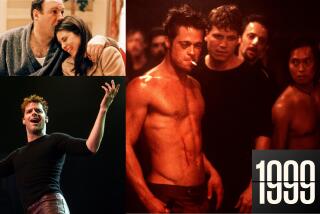LIFE OUTSIDE THE LINES
1902
Movies
The release of “Le Voyage dans la Lune” (A Trip to the Moon), by Georges Melies, perhaps the first great fantasy filmmaker.
*
1914-1918
World War I
The optimistic idealism fueling the Modern Age was stunned and deformed by the most brutal human conflict in recorded history.
*
1920
Radio
Pittsburgh-area radio station KDKA broadcasts the first scheduled music program. It’s the first step in a relationship that would take pop music into virtually every home and car in America.
*
1923
Music
Arnold Schoenberg puts another nail in harmony’s coffin with his Five Piano Pieces, Op. 23, the first example of 12-tone music, in which each tone of the scale is made independent from all others.
*
1927
Theater
Florenz Ziegfeld produces a musical version of the Edna Ferber soaper “Show Boat,” at a time when musical theater was girls, girls, girls, and gags, gags, gags. Only “Oklahoma!” in 1943 pushed the medium forward as far.
*
1928
Movies
An icon is born: Mickey Mouse debuts in “Steamboat Willie.”
*
1933
Radio
President Franklin D. Roosevelt uses the airwaves to calm a panicked nation with his intimate “Fireside Chats.”
*
1935-38
Jazz
Billie Holiday and Ella Fitzgerald transform the styles of Louis Armstrong and Bessie Smith into the two dominant styles of jazz singing.
*
1944
Pop Music
Woody Guthrie is signed to Folkways Records, where he recorded the songs, including “This Land Is Your Land,” that established him as the most important figure in folk music.
*
1945-55
With Europe in ashes after World War II, American art moves to center stage.
*
1946
Pop Music
Les Paul invents the solid-body electric guitar. The Gibson Co. is initially unimpressed, but the electric guitar becomes the defining instrument of rock.
*
1956
Pop Music
James Brown records “Please, Please, Please,” the first of 118 rhythm & blues hits by the hardest-working man in show business.
*
1959
Movies
“Ben-Hur” captures 11 of the 12 Academy Awards it is nominated for, setting a record that stood for nearly 40 years, until “Titanic” tied it in 1998.
*
1960s
Art
The Pop-Minimal-Conceptual Art Watershed. Modern art ends, contemporary art begins.
*
1962
Pop Music
Bob Marley makes his recording debut in Jamaica, the start of a journey that made reggae an international pop force and opened doors for world music.
*
1963
Art
Betty Friedan, “The Feminine Mystique.” The contemporary feminist movement is launched, and with it the single most influential social development for postwar art.
*
1965-70
Jazz
Miles Davis leads several classic groups--first with Herbie Hancock, Wayne Shorter, Ron Carter and Tony Williams, later with Chick Corea, Jack DeJohnette, John McLaughlin and others--that adopt electronics and rock rhythms.
*
1967
Pop Music
The Moog arrives. Robert A. Moog introduces a commercially viable synthesizer, challenging the dominance of the guitar in post-World War II pop.
*
1972
Movies
Francis Ford Coppola’s “The Godfather” achieves what Hollywood’s 1970s New Wave always hoped was possible: a huge artistic as well as commercial success.
*
1976
Pop Music
The Sex Pistols’ “Anarchy in the U.K.” signals the start of punk rock in England.
*
1989
Theater
On enormous cat-feet, “Cats” outruns “A Chorus Line” to become the longest-lived Broadway show in history, as well as the most profitable theatrical venture of all time.
*
1990-92
The Arts
The 1990 death of 32-year-old graffiti artist Keith Haring becomes an emblem of artistic promise cut short by the AIDS epidemic. The oft-chronicled crisis finds its most effective dramatization in Tony Kushner’s epic “Angels in America,” which premiered in its entirety in 1992 at the Mark Taper Forum in L.A.
More to Read
The biggest entertainment stories
Get our big stories about Hollywood, film, television, music, arts, culture and more right in your inbox as soon as they publish.
You may occasionally receive promotional content from the Los Angeles Times.










